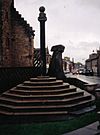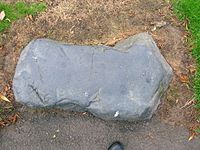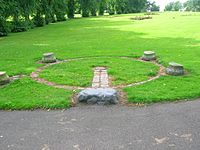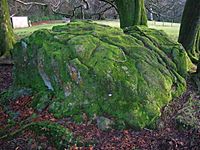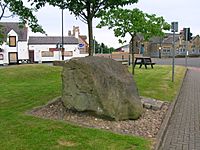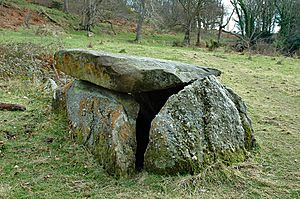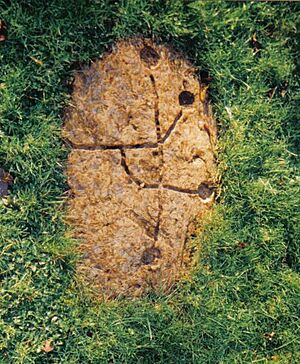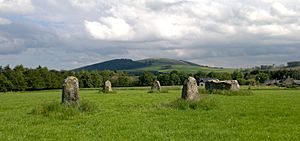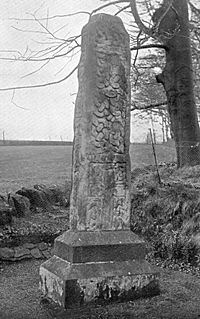Stones of Scotland facts for kids
The stones of Scotland are really cool! They are big rocks that have been important to people for a very long time. Some are famous for their history, and others have mysterious carvings. Let's explore some of these amazing stones!
The Stone of Scone
The Stone of Scone, also called the "Stone of Destiny," is a famous block of sandstone. For hundreds of years, it was used in the special ceremonies where kings and queens of Scotland were crowned. Later, it was used for the kings and queens of England and then British monarchs. This important stone was kept at an old abbey in Scone, near Perth.
Rocking Stones
Imagine a huge stone that can actually rock back and forth! These are called rocking stones. Scotland, especially a place called Ayrshire, has many of them. Some still rock, while others used to.
A rocking stone near Coylton in Ayrshire is super big, weighing about 30 tons! It sits on two smaller stones. There's also a large standing stone nearby called Wallace's Stone.
Another rocking stone is found near Loch Riecawr in South Ayrshire.
In Straiton District, there's a rocking stone called the Logan Stone. It's a grey granite rock that's about 4 feet tall. You can easily move it with just one hand!
On Cuff Hill in Hessilhead, near Beith, there's a rocking stone that some people connect to the Druids. Sadly, it doesn't rock anymore because people dug underneath it to see how it worked.
The Lamagee or Lamargle stone is in the middle of a stone circle in Lugar. Local stories say it used to rock, but it doesn't now.
Near Lugar, there's another rocking stone by the Bella Water. It's made of two upright stones and a horizontal one. People used to think it was a Druid monument or a hero's grave.
There was also a rocking stone at Sannox on Arran, right by the seashore.
The Clochoderick stone near Howwood and Kilbarchan used to rock. Legend says the Druids used it to decide if people were innocent or guilty. If you sat on it, the way it moved would tell them! It's also said to be the burial place of Rhydderch Hael, a king who brought Christianity to his area.
Lochmaben Stone
The Lochmaben Stone is a very old and famous stone in Scotland. It stands in a field near the Sark mouth on the Solway Firth. This stone is huge, about 7 feet tall and 18 feet around, weighing about ten tons! It's a type of rock called an "erratic," meaning it was moved there by glaciers long, long ago.
Thurgartstone
The Thurgartstone, also called the Ogrestone, near Dunlop in East Ayrshire, was probably a rocking stone once. But over many years, soil has built up around its base, so it can't rock anymore. This stone is a glacial erratic, meaning it was carried by ice and left behind.
The Carlin or Hag's Stone
On top of the Common Crags overlooking Dunlop, there's a big stone called the 'Carlin's Stone'. A "Carlin" is an old Scots word for a witch or an "old Hag." So, this is known as the Witch's Stone. There are a few stones with this name in Scotland.
The word "Carlin" is similar to the Gaelic word "Cailleach," which means an old woman or a goddess of winter. This makes the stone quite mysterious!
The Stone of Mannau
The town of Clackmannan gets its name from the Gaelic words "Clach Mhanainn," which means 'Stone of Manau'. This stone is a monolith, a single large stone, that was very important to the ancient people of the area for religious reasons. It's been moved from its original spot and now sits in the town center.
The Dagon Stone
The Dagon Stone in Darvel, Ayrshire, is a big, unshaped stone that might be a prehistoric standing stone. It has twelve small connected dips on its sides. Some people think these dips might have been used to watch the stars or the sun, perhaps to mark the longest day of the year. This would connect the stone to ideas of life, good crops, and good fortune.
In 1821, someone put a round sandstone ball on top of it with an iron bar, but no one knows why! This stone used to be in the main street and was moved to the town square when the road was made wider.
Old records show that before the 1800s, newly married couples and their guests would walk around the Dagon Stone for good luck, often with a fiddler playing music. Wedding groups would even walk around it three times in a sunwise direction on their way to the bride's house.
There was also an annual parade where people would walk sunwise around the Dagon Stone out of respect.
The Dooslan Stone
This large stone, called a glacial erratic, is now in Brodie Park in Paisley. It's thought to be named after a Mr. Dove who claimed the stone. It used to be a meeting place for the Weavers Union and was also used as a "soapbox" for people to give speeches. It's still used today as a meeting point for a yearly parade. We don't know its oldest meaning, but it has clearly been important to people for a long time.
Other Interesting Stones of Scotland
The Carlin Stone at Craigends
Another large stone called the 'Carlin's Stone' is found near Craigends Farm in East Ayrshire. It's next to the Carlin Burn. This stone was visited a lot in the past, and you can still see where a footbridge used to lead to it.
The Deil's Chuckie Stane at Ladyland
This is a large boulder among trees near Ladyland House in Kilbirnie, North Ayrshire. "Deil's Chuckie Stane" means "Devil's Pebble Stone," but there isn't a clear story about why it has this name. It's amazing that this stone survived even when old castles and farm buildings were built nearby.
The Grannie Stane at Irvine
The Grannie Stane in Irvine is a bit of a mystery! It's either a huge boulder left behind by the Ice Age, or it's the last stone from an old stone circle. Other stones were removed when a weir was built in 1895, but people protested and saved this one. You can see the Grannie Stane when the water levels are low.
The Hare Stone
The Hare Stone is a large glacial erratic boulder. It used to be in a field but was moved to the center of Monkton, near Prestwick, in 2000. There are many old stories about witches and evil spirits connected to this stone.
The Gowk Stane
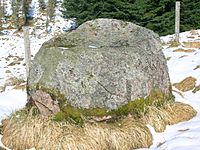
Near Laigh Overmuir, on the moors above Darvel in East Ayrshire, is the Gowk Stane. This is another glacial erratic boulder that sits in a very noticeable spot, looking over the Glen Water.
The Haylie Chambered Tomb
In Largs, North Ayrshire, there's a neolithic tomb behind Douglas Park. This ancient monument is called the Haylie Chambered Tomb. It was once covered by a mound of stones. When it was uncovered in the early 1900s, experts figured out it was built around 3000 to 2000 BC! A chambered tomb is like an ancient burial room made of large stones.
Cup and Ring Mark Stone
Cup and ring marked stones have mysterious carvings on them. We don't know their exact purpose, but they might have been like family trees, star maps, or even related to labyrinths. These carvings are super old, dating back to the Neolithic or Bronze Age times, up to 6000 years ago! The example from Dalgarven Mill is special because it has cups and connecting lines, but no rings.
Scottish Standing Stones
Stone Arrangements
Scotland has many amazing stone circles and other stone arrangements, like the famous Callanish Stones. These are groups of stones placed in special patterns.
- Calanais (Callanish I)
- Callanish II
- Callanish III
- Callanish IV
- Callanish VIII
- Callanish X
- Cullerlie stone circle
- Dunnideer stone circle
- Easter Aquhorthies
- Loanhead of Daviot stone circle
- Ring of Brodgar
- Sunhoney
- Temple Wood
- The Ringing Stone
- Rothiemay Stone Circle
Scottish Standing Stones
Besides circles, there are also many famous lone standing stones in Scotland. These are single, tall stones that were placed upright long ago.
- Achavanich
- Ballymeanoch
- Clach an Trushal
- Comet Stone
- Hill o'Many Stanes
- Nether Largie
- Stones of Stenness
- Watch Stone
- Maiden Stone
- Yarrow Stone, Selkirk
- Dunfallandy Stone
- Picardy Stone
Scottish Picture Stones
Some stones in Scotland are famous for having special carvings or "pictures" on them.
- The Goose Stone
- Tillytarmont
- Red Hill Stone
- Aberlemmo Territorial Stone
Scottish Recumbent Stones
"Recumbent" means lying down. These are stones that are placed horizontally, often as part of a stone circle.
- Easter Aquhorthies Recumbent Stone Circle
- Korskellie Recumbent Stone
- Avochie Recumbent Stone
- The Wolf Stone, Brora, East Sutherland
- Brandsbutt Stone
- Carlin stone, Dunlop, East Ayrshire
Images for kids


